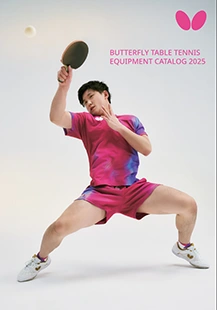Feature]
[Special feature] America’s star! Jha’s strong points
#4 Short Pushes that don’t let the opponent take the initiative (final episode)

Kanak Jha (USA) made it to the quarterfinals of the men’s singles at the 2021 World Table Tennis Championships in Houston, and the quarterfinals of the men’s singles at the recent Paris Olympics. At first glance, he plays with an orthodox shakehand style of attack, staying up front and not too far from the table, but inside he is packed with a variety of intelligent moves needed to win. In this special feature, we will reveal Jha’s strengths, including comments from him and his coach, Jorg Bitzigeio (Germany).
In the final episode, he explains Jha’s hidden weapon, the short push.
*The technical explanation in the main text is based on a right-handed player.
By applying strong spin to the push, it becomes a more aggressive technique.
Bitzigeio: With regards to Jha’s receiving, we are strengthening his push. Specifically, push at an early timing. Furthermore, hitting the ball as if pushing it and putting a lot of spin (underspin) on it (short push). For this reason, we are focusing on the speed of the timing of the receipt, and are also doing training to strengthen the wrist. Jha: When making a push, it’s important to capture at the early point of impact. To do this, it’s important to get close to the ball quickly. This is because getting closer to the ball makes it easier to control the racket. And by putting a lot of spin on the push, it becomes a more aggressive receiving technique. If you put a lot of spin on the push, it will be difficult for your opponent to flick (sweep) or banana-flick (a backhand drive technique for the ball on the table), and it will be difficult to control if you try to do a push return (atechnique of returning a push with a push).

Jha (right) and his coach, Bitzigeio, say they are working on improving their push skills when receiving.
Cancel the opponent’s serve spin with an early hitting point
Jha: To impart strong spin to a push, you need to correctly read the rotation of your opponent’s serve and create the correct racket angle according to that rotation. However, if you aim for an early point of impact and hit the ball with the intention of putting spin on it yourself, you can negate any slight misreading of the rotation of your opponent’s serve or the racket angle in relation to it. So, to reiterate, capturing an early point of impact is a key point in improving the stability of this technique.When making a short push, I think it’s good to hit the ball with the image of holding it for a long time. That way, it will be easier to put strong spin on the ball.Forehand he
Forehand heavy push

Backhand heavy push

It’s hard to notice at first glance when watching Jha play, but his ability to induce mistakes from opponents and take the initiative with a short push is one of his hidden strong points. It’s not easy to keep the ball short and control it while also putting strong underspin on it, but if you
can master it, it will be a powerful weapon. What’s more, if you can make a short push with both forehand and backhand like Jha can, it will further expand the variety of your receives. Players who are looking to improve their receiving should use Jha’s comments and sequence of
photos as a reference and try to master the short push.
Watch the video here

(Interview/Summary = Table Tennis Report)























